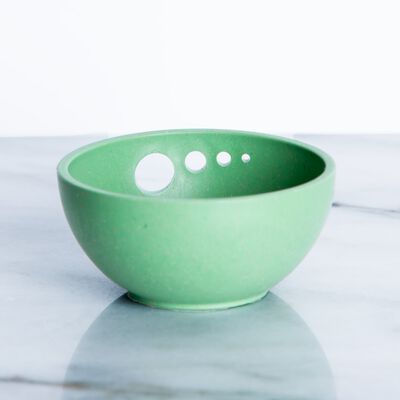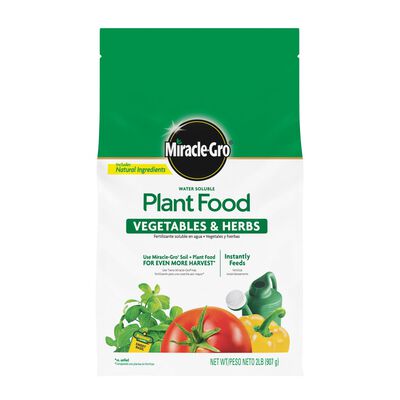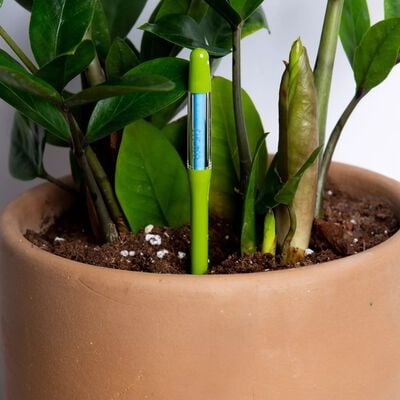
Your Guide To: Rosemary Plant Care
Everything you need to care for this potted Mediterranean herb.
Whether it's used fresh or dried, sprigs of rosemary add a peppery and robust flavor to everything from breakfast dishes to your evening cocktail, and even savory desserts. It also adds a pop of rustic green to your indoor herb garden.
Woodsy, warm rosemary is the perfect addition to the herb lover's kitchen, plus it adds whimsical and beauty to your space. Rosemary that grows wild outdoors produces light pink, blue, or white flowers. But rosemary that is grown indoors is unlikely to bloom, mostly because keeping rosemary healthy will mean harvesting it frequently enough to prevent flower buds from appearing.
How to Keep a Rosemary Plant Happy
How Much Lighting Does a Rosemary Plant Need?
How Do I Know When To Water My Rosemary Plant?
Rosemary plants like their soil on the dry side, and won't be able to adapt to over-watering. As a rule of thumb, this herb needs water every week — but you'll need to monitor the soil to know for sure what your rosemary needs. Every few days, test the soil by feeling the top inch or two of soil with your fingertip (or better yet, take all the guesswork out of watering with a Plant Moisture Indicator from our Accessories shop).
When the top two inches of soil feel dry to the touch, saturate your rosemary plant's potting soil with water from a small container or watering can. Pour water out slowly, moving in a clockwise motion so that you can evenly water your plant's roots. Any excess water will drip into the tray at the bottom of your plant. Rosemary plants don't appreciate having their roots sit in water, so remove this water before returning your plant to its place.
How Do I Use Plant Food for My Rosemary Plant?
Plant food is an important part of fostering health vine growth and new leaves as your plant gets used to its new digs.
For a kitchen-size rosemary plant in a container that's between 5 and 6 inches in diameter, insert 3 new plant food spikes (included with your plant purchase) into the soil once a month during the spring and summer. During the fall and winter, when the rosemary plant is dormant, you can add plant food to soil every two months.
What Is a Rosemary Plant's Ideal Environment?
Rosemary plants do well when they can absorb some water from the air. You can add some wet pebbles or gravel to your rosemary plant’s saucer to give it a humidity boost. Occasionally misting your rosemary plant is also beneficial.
Keep the average room temperature in your home between 65 and 80 degrees, and keep your rosemary plant out of drafty areas for best growth.
How Do I Prune and Maintain My Rosemary Plant?
A kitchen-sized rosemary plant will grow several inches every year, so it makes sense to have pruning shears on hand to prune back old leaves and make room for new growth. Leaves that are yellowed, brown, or damaged can be pruned back at any time.
Remember to rotate your plant a quarter turn every time you water it to make sure that light is being distributed evenly to each part of your rosemary plant — our plant trivet set makes this easy and stylish, too.
How Do I Harvest My Rosemary Plant?
Our rosemary plants arrive ready to harvest. Using pruning shears, you can snip a sprig of rosemary and use the needle-shaped leaves while they are still bendy and fresh. It’s safe and even beneficial for your rosemary to harvest from it often, but be careful not to prune off more than one-third of the plant’s stems at a time.
You can also set newly-plucked rosemary sprigs on your kitchen counter to let them dry out a bit, or use a food dehydrator to create rosemary that is more like what you’d find in a spice jar. Keep in mind, though, that dried rosemary is less flavorful than fresh rosemary.
The only way the process could be simpler is if you use a tool like our Pull and Pinch Herb Harvester to quickly and easily separate rosemary leaves from their stems.

How to Address Common Rosemary Plant Issues
Most common rosemary plant issues are caused by overwatering or a lack of light.
- A light gray, powdery fungus on your rosemary plant is called powdery mildew. A lack of air circulation can cause this fungus to form. If there is poor air circulation in your kitchen, consider moving your rosemary to a room with a ceiling fan, at least temporarily, or leaving some windows open during warmer months. Use pruning shears to snip off infected parts of the plant if this happens. Use rubbing alcohol to disinfect scissors or pruning shears afterward to avoid spreading the fungus to other plants
- Dropping leaves can mean that your rosemary isn't getting enough light. Try moving your rosemary closer to its primary light source, or consider adding a fluorescent lamp to your rosemary's environment.
What to Do If You Still Have Questions
If your rosemary plant doesn’t seem to feel at home in your space, we’re here to help! You can chat with a live Greendigs representative on our website. You can also shoot us an email at [email protected]


